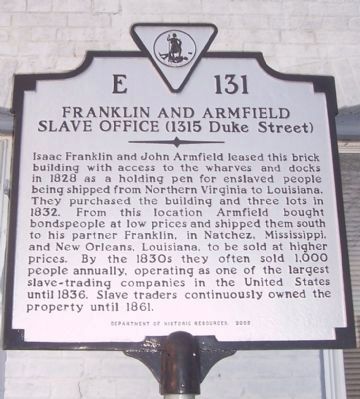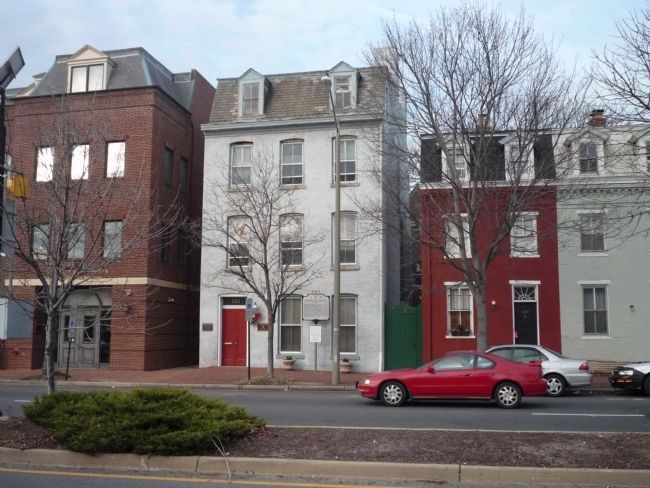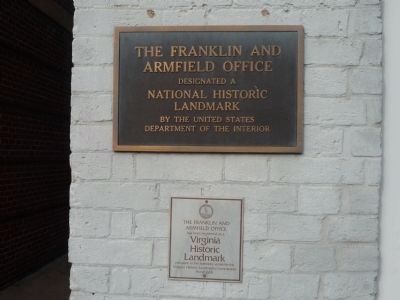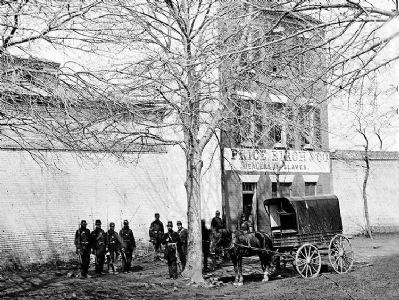Southwest Quadrant in Alexandria, Virginia — The American South (Mid-Atlantic)
Franklin and Armfield Slave Office
(1315 Duke Street)
Erected 2005 by Department of Historic Resources. (Marker Number E-131.)
Topics and series. This historical marker is listed in these topic lists: African Americans • Industry & Commerce • War, US Civil. In addition, it is included in the National Historic Landmarks, and the Virginia Department of Historic Resources (DHR) series lists. A significant historical year for this entry is 1828.
Location. 38° 48.233′ N, 77° 3.283′ W. Marker is in Alexandria, Virginia. It is in the Southwest Quadrant. Marker is on Duke Street (Virginia Route 236). Touch for map. Marker is at or near this postal address: 1315 Duke Street, Alexandria VA 22314, United States of America. Touch for directions.
Other nearby markers. At least 8 other markers are within walking distance of this marker. 1323 Duke Street – From Slavery to Freedom and Service (a few steps from this marker); Shiloh Baptist Church (within shouting distance of this marker); L'Overture Hospital HQ (within shouting distance of this marker); L’Ouverture Hospital (about 400 feet away, measured in a direct line); Capt. James McGuire House (about 700 feet away); Freedom House Museum (about 800 feet away); The Growth of Upper King Street (about 800 feet away); James Harris House (about 800 feet away). Touch for a list and map of all markers in Alexandria.
Related markers. Click here for a list of markers that are related to this marker. To better understand the relationship, study each marker in the order shown.
Also see . . .
1. Franklin and Armfield. (Submitted on December 5, 2008, by Richard E. Miller of Oxon Hill, Maryland.)
2. Franklin and Armfield Office. (Submitted on December 5, 2008, by Richard E. Miller of Oxon Hill, Maryland.)
3. Alexandria Black History Museum - "A Loathsome Prison . . .". (Submitted on December 23, 2008, by Richard E. Miller of Oxon Hill, Maryland.)
4. City of Alexandria to Purchase Freedom House to Preserve Historic Museum. (Submitted on January 8, 2020, by Devry Becker Jones of Washington, District of Columbia.)
Additional commentary.
1. Franklin and Armfield and the U.S. Internal Slave Trade
... Slaves awaiting shipment to markets in New Orleans and Natchez were imprisoned in walled pens behind the house. At night they slept in a two-story rear wing with grated doors and windows. ...
For enslaved Blacks in Virginia, there were few fates worse than Duke Street. “Louisiana was considered by slaves a place of slaughter,” wrote emancipated slave Jacob Stroyer. With the same sentiment, Rev. Josiah Henson, thought to be the basis for Harriet Beecher Stowes’ fictional Uncle Tom, wrote in his autobiography that the fear of being sold south filled slaves of the upper South with “perpetual dread.” But selling slaves south filled the pockets of slave traders with perpetual profits. ... “We will give Cash for one hundred likely YOUNG NEGROES,” read one Franklin and Armfield ad in the Alexandria Gazette in 1828. “Persons who wish to sell, would do well to give us a call, as the negroes are wanted immediately. We will give more than any other purchasers that are in the market or may hereafter come into the market.”
In mid- to late summer, slave drivers armed with guns and whips, marched a chained and manacled coffle of slaves through Tennessee to the Forks of the Road slave market in Natchez. ... Every month from October to May, the firm also shipped slaves from Alexandria to New Orleans on their fleet of steamboats and ships, including one named for partner Isaac Franklin. ...
At the firm’s peak in the 1830’s it sold between 1,000 and 1,200 slaves a year, making it a key player in the interstate slave commerce that transported enslaved Blacks from Upper South hubs in Baltimore, the District of Columbia (of which Alexandria was a component until 1846), Richmond, Norfolk, Nashville and St. Louis to markets in Charleston, Savannah, Mobile, Natchez, and New Orleans.
Between 1820 and 1860 about 650,000 people were sold across state lines (twice as many as were traded locally); and the business generated by Franklin and Armfield accounts for Washington, D.C./Alexandria's, reputation as the foremost slave trading center of the era....
In 1846 the Duke Street property was purchased by a Franklin & Armfield agent, George Kephart, and in 1858 to a third slave trading firm, Price, Birch, and Co. The Adamesque structure, built in 1812 for General Andrew Young, was used to jail Union army deserters and house freed “contraband” Blacks after Alexandria fell to Union troops in 1861. In 1863 the building provided the first meeting place for Shiloh Baptist Church, founded by former slaves housed there. The slave pens were demolished in the 1870s.
[Extracted mainly from: <http://www.aaheritageva.org/search/sites.php?site_id=476>
Virginia Foundation For the Humanities, African American Heritage Program.]
— Submitted December 5, 2008, by Richard E. Miller of Oxon Hill, Maryland.
Additional keywords. Internal slave trade; George Kephart; Price, Birch, and Co.; L'Ouverture Hospital; Prison; Contraband; Freedmen; Urban League; Freedom House; human trafficking.
Credits. This page was last revised on January 27, 2023. It was originally submitted on December 5, 2008, by Richard E. Miller of Oxon Hill, Maryland. This page has been viewed 7,709 times since then and 103 times this year. Last updated on March 27, 2014, by Richard E. Miller of Oxon Hill, Maryland. Photos: 1. submitted on December 5, 2008, by Richard E. Miller of Oxon Hill, Maryland. 2, 3. submitted on December 23, 2008, by Richard E. Miller of Oxon Hill, Maryland. 4. submitted on February 17, 2010, by Richard E. Miller of Oxon Hill, Maryland. • Bernard Fisher was the editor who published this page.



